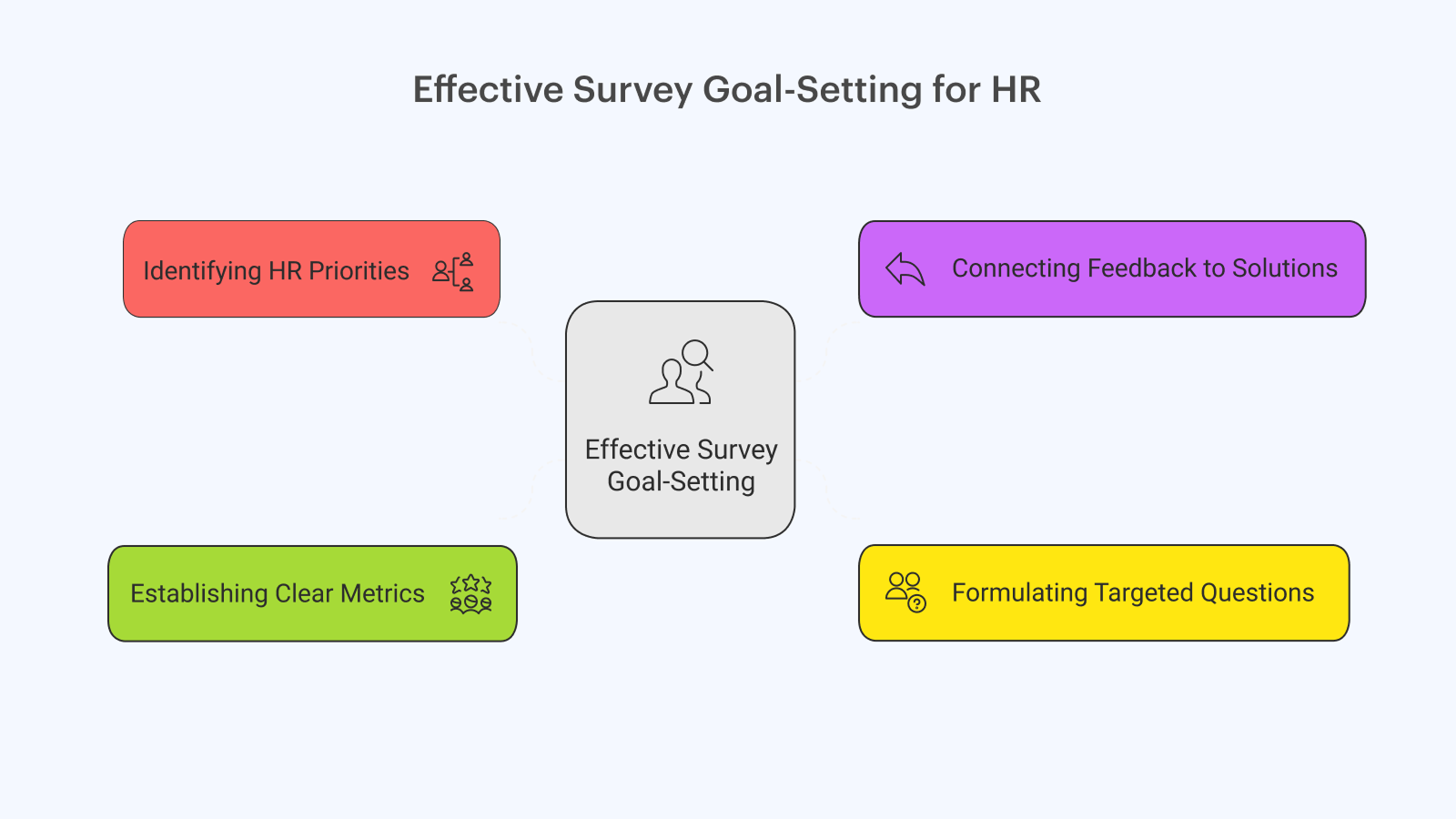Introduction
In today's competitive business environment, maintaining high job satisfaction and employee morale is crucial. According to recent Gallup job satisfaction statistics, only 34% of the workforce feel actively engaged. Such low engagement indicates serious issues with employee morale and highlights why HR and management should urgently implement measures to improve workplace culture.
A proven way to evaluate and enhance employee experience is through an employee satisfaction survey. Such surveys measure job satisfaction, reveal employee needs, and help managers spot hidden workforce issues. For instance, surveys can show if team members feel overworked, undervalued, or disconnected. Analyzing these results allows HR to address concerns promptly, improving productivity and morale.
Effective employee satisfaction surveys:
- Clearly measure employee perceptions.
- Identify workplace strengths and weaknesses.
- Guide data-driven HR actions.
🚀 Thoughtful interpretation of survey results is key. It ensures decisions are relevant and effective, directly improving workforce engagement and job satisfaction.
Setting the Foundation: Before You Survey Employees
Define Goals and Align with HR Objectives
Before launching an employee survey, HR needs clear goals aligned with organizational objectives. Without specific goals, a survey may become just another formality, rather than a tool to measure employee satisfaction and improve the work environment.

Effective survey goal-setting includes:
- Identifying HR priorities: Clearly define what HR challenges the survey will address, such as employee retention, diversity and inclusion, or productivity improvements.
- Connecting feedback to solutions: Plan how employee responses will help HR tackle these specific issues. For example, if retention is an issue, survey questions could focus on factors influencing employee loyalty.
- Formulating targeted questions: Craft specific questions that directly address HR objectives. Generic questions lead to generic insights.
- Establishing clear metrics: Set measurable targets for response rates, participation levels, and planned post-survey actions.
Example of clear survey objectives:
| HR Challenge | Sample Survey Question | Targeted HR Action |
| Low employee retention | "What factors contribute most to your job satisfaction?" | Develop retention-focused benefits |
| Diversity and inclusion | "Do you feel valued and respected at work?" | Launch inclusivity training |
Choose the Right Survey Platform
The choice of survey platform affects participation and quality of results. Platforms like SurveyMonkey or CultureAmp offer helpful HR-focused features. Evaluate survey tools by the following key factors:
| Platform Feature | Why Important for HR | Example |
| Mobile-friendly | Higher response rate; easier participation | Completing surveys via smartphone |
| Anonymous responses | Honest feedback without fear of repercussions | Employees openly sharing concerns |
| Advanced analytics | Quickly identify trends and actionable insights | Easy reporting of employee trends |
| Customizable templates | Tailored to your HR goals | Questions customized to challenges |
| HR system integration | Efficient management of survey results | Survey results linked with HR software |
Choosing a platform that meets these criteria helps HR effectively measure employee satisfaction and gain meaningful insights.
Survey Timing and Frequency: Pulse vs Annual
HR must carefully consider the timing and frequency of employee surveys. The two primary types are pulse surveys and annual employee surveys:
| Survey Type | Frequency | Advantages | Disadvantages |
| Pulse survey | Monthly or quarterly | Fast insights; quick reaction to issues | Risk of survey fatigue |
| Annual survey | Once per year | Comprehensive data; year-over-year benchmarks | Lower agility and possible lower response rate |
A pulse survey provides regular updates on employee experience, helping HR quickly identify issues like workload or morale dips. But too frequent surveys can cause survey fatigue, reducing response rates.
Annual surveys are better suited to deep, comprehensive analysis. They capture the employee experience fully, allowing benchmarking against previous years. However, annual surveys can miss sudden workforce issues due to their infrequency.
A balanced approach is combining both survey types:
- Pulse surveys: Quickly spot and correct immediate problems.
- Annual surveys: Track long-term HR progress and overall employee satisfaction.
🧠 The Harvard Business Review also emphasizes that to effectively measure employee experience, frequent short surveys and annual comprehensive surveys should be combined to see the full picture of changing employee expectations (HBR, 2023).
Crafting Employee Satisfaction Survey Questions That Work
How to Choose the Right Questions Related to Goals
The quality of insights from your employee survey depends directly on the clarity and relevance of your questions. Good questions lead to actionable answers; poor ones waste everyone's time.

Here’s how HR can ensure survey questions align closely with organizational goals:
1. Match questions to metrics
Use questions that connect directly to HR KPIs — employee Net Promoter Score (eNPS), engagement, satisfaction ratings.
Example: To measure engagement, ask: "On a scale of 1 to 5, how motivated do you feel at work?"
2. Balance open and closed questions
Combine quantitative Likert scale questions (rating agreement from 1–5) with qualitative open-ended ones for detailed insights.
Example: Pair "Rate your satisfaction with team collaboration" with "What could improve teamwork?"
3. Clarity and simplicity
Questions should be easy to understand, avoiding jargon. Clear wording increases response accuracy.
Example: Instead of "Evaluate your perceived utilization rate," ask "Do you feel your skills are fully utilized?"
4. Encourage honest answers
Assure employees their responses are anonymous to foster openness. Frame questions to avoid biases.
Example: Rather than asking, "Do you think your manager is fair?", say, "How comfortable are you voicing concerns to your manager?"
25+ Employee Survey Questions for Your Next Survey
Below are practical survey question examples across five key HR areas. Adapt them to match your survey goals:
Job Satisfaction
- "On a scale of 1–10, how satisfied are you with your role?"
- "What aspects of your job motivate you most?"
- "Do you feel your tasks match your skills and abilities?"
- "How clearly do your responsibilities align with your job description?"
- "What improvements would increase your job satisfaction?"
Leadership & Management
- "Does your manager clearly communicate expectations?"
- "On a scale of 1–5, how supported do you feel by your supervisor?"
- "How frequently do you receive constructive feedback?"
- "Do you feel comfortable approaching your manager with concerns?"
- "What can leadership do to better support your daily work?"
Company Culture
- "Do you feel a sense of belonging at the company?"
- "On a scale of 1–5, rate our commitment to diversity and inclusion."
- "Can you comfortably be yourself at work?"
- "How consistently does the company embody its stated values?"
- "What three words describe our work environment?"
Employee Wellness
- "Rate your current work-life balance (1–5)."
- "Do you feel recognized for your contributions?"
- "How effectively can you manage stress and avoid burnout?"
- "Which wellness initiatives would you like implemented?"
- "Do you have adequate resources to perform your job?"
Growth & Recognition
- "Is there a clear path for your career advancement here?"
- "On a scale of 1–5, how satisfied are you with learning opportunities?"
- "Is your compensation fair and competitive?"
- "How often do you feel recognized for your efforts?"
- "What additional support would help you grow professionally?"
Sample Wellness Survey & Engagement Survey Templates
Ready-made survey templates help HR quickly launch targeted surveys and gain immediate insights into specific areas of employee experience:
Employee Wellness Survey Template (15 questions)
Purpose: Evaluate employee health, well-being, and balance.
Main sections:
- Physical wellness (fitness initiatives, health benefits)
- Mental health (support and stress management)
- Work-life balance (flexible schedules, workload concerns)
- Tools and resources (adequacy for job performance)
Employee Engagement Survey Template (20+ questions)
Purpose: Measure engagement, identify drivers, and highlight areas needing improvement.
Main sections:
- Core engagement metrics (motivation, commitment)
- Managerial effectiveness (support, feedback quality)
- Cultural alignment (shared values, sense of belonging)
- Career development (opportunities for growth)
Both templates integrate smoothly into platforms like SurveyMonkey or CultureAmp, making it easy for HR to adapt, deploy, and analyze results quickly.
Summary Table: Question Types & Their Uses
| Question Type | Use Case | Sample Question |
| Likert scale (quantitative) | Quick, measurable feedback on satisfaction, agreement, or frequency | "Rate your satisfaction with work-life balance from 1 to 5." |
| Open-ended (qualitative) | Detailed insights, explanations, and suggestions | "What specific changes would improve team collaboration?" |
By choosing the right types of questions, HR ensures every employee satisfaction survey delivers meaningful insights and measurable improvements.
Analyzing Employee Satisfaction Survey Results
Top Metrics and KPIs to Track from Survey Results
Proper analysis of employee satisfaction survey results relies on clearly defined metrics that HR can act on. Here's what to track first:
- Response Rate: Percentage of employees who completed the survey. Low rates (<70%) might signal workforce disengagement or survey fatigue. Aim for 75–80% for reliable insights.
- Employee Net Promoter Score (eNPS): Measures how likely employees would recommend your company as a workplace. High scores correlate strongly with retention. Example Question: "How likely are you to recommend our company as a great place to work?"
- Sentiment Score: Uses AI-enhanced analysis of open-ended questions to measure the positivity or negativity of employee feedback. A sentiment score above 65% positive indicates healthy workforce sentiment.
- Engagement Index: Combines pride, commitment, and discretionary effort into one comprehensive score. High employee engagement typically predicts better productivity and retention. Benchmark: Organizations with strong engagement outperform peers by about 17%.
- Theme Frequency: Identifies the most frequently mentioned topics or issues in qualitative feedback, highlighting priority areas.
To improve actionability, segment these KPIs by department, tenure, and job role:
| Metric | Measures | Ideal Benchmark |
| Response Rate | Employee participation | 75–80%+ |
| eNPS | Likelihood to recommend workplace | +10 to +50 |
| Sentiment Score | Tone of open-ended feedback | 65%+ positive |
| Engagement Index | Composite of key engagement questions | 70%+ |
| Theme Frequency | Key feedback areas | Identify top 3–5 issues |
Job Satisfaction Statistics to Benchmark Internally and Externally
Benchmarking provides critical context for your job satisfaction data, both internally over time and externally against industry standards.
Internal benchmarks track organizational progress:
- Changes in satisfaction quarter-over-quarter by department.
- Year-over-year satisfaction trends across demographic groups.
- Correlation between manager effectiveness scores and retention.
External benchmarks show where your workforce stands compared to others:
| Benchmark Type | Example Metric | Industry Example |
| Industry-specific | High employee engagement rates | Financial services (~42%) |
| Regional | Local job satisfaction averages | Adjust based on regional economy |
| Company size | Satisfaction levels by company scale | Small organizations typically higher |
Tools and Tips for Data Visualization & Text Analysis
Clear visualization and smart text analysis help transform raw survey data into actionable strategies. Recommended tools and methods:
- Interactive Dashboards: Allow managers to filter data by department or tenure without involving analysts directly. Example platforms: Tableau or Power BI.
- Word Clouds with Context: Visualize open-ended feedback to quickly identify frequently mentioned concerns along with their sentiment.
- AI-enhanced Theme Clusters: Automatically group similar qualitative responses, revealing hidden patterns or emerging employee issues.
- Sentiment Over Time Tracking: Measure how employee feelings about specific initiatives change following HR interventions, guiding continuous improvement.
- Automated Alerts: Set thresholds on critical metrics (like sudden drops in engagement) to promptly inform HR of urgent issues.
📝 Example analysis scenario
HR notices a drop in sentiment scores in the sales team. An AI-enhanced analysis reveals workload and recognition issues. HR can then promptly intervene by reallocating tasks and boosting recognition programs, improving overall job satisfaction.
Quick Comparison of Analysis Techniques:
| Technique | Best Use Case | Example Application |
| Interactive Dashboards | Leadership self-service data exploration | Managers viewing departmental results |
| AI Theme Clusters | Identifying hidden employee concerns | Automatically grouping feedback |
| Sentiment Tracking | Measuring intervention effectiveness | Tracking sentiment pre/post training |
Choosing focused tools and clear KPIs ensures your employee satisfaction surveys consistently translate into actionable insights and real workforce improvements.
Work analytics from the office: understand your employees to increase engagement
To gain a deeper understanding of why employees feel tired or less engaged, analytics from surveys alone may not be enough. It's important to see how people actually interact with the office space: which areas are popular, which areas are empty, and which days of the week the office is most utilized.
UnSpot's Office Analytics service can help you accurately track these nuances. For example, it will show HR and managers how many employees come to the office on different days, which zones are used most often, and which ones remain unused. For example, if an employee satisfaction survey shows that employees often complain about noise, the analytics will help you understand in which specific zones it occurs most often and why.

Implement Employee Feedback Effectively
From Survey Results to Action Plans: A Step-by-Step Guide
Implementing meaningful changes based on employee satisfaction survey feedback requires a clear action plan. Follow this structured approach:

Step 1. Identify Meaningful Patterns
Don’t just review averages — group responses by department, job role, or themes. Compare new survey results with previous surveys. Identify critical issues (scores below 60%) and strengths (above 85%).
Example: A software firm had overall satisfaction at 78%, but collaboration scores in engineering dropped to 55%, indicating a priority area.
Step 2. Prioritize Issues Using the Impact/Effort Matrix
Prioritize feedback strategically, considering both impact on employee morale and effort required.
| Low Effort | High Effort | |
| High Impact | 🔥 Quick Wins (Priority 1) | 🔄 Major Projects (Priority 2) |
| Low Impact | 👍 Easy Fixes (Priority 3) | ⏱️ Low Priority (Priority 4) |
Gallup Global Workforce Study confirms that companies that respond to employee satisfaction survey results in a timely manner have one-third more engaged employees and significantly lower turnover rates (Gallup Global Workforce Study).
Step 3. Set SMART Initiatives
Each item in your action plan should be specific and measurable:
- Specific: Clearly defined actions.
- Measurable: Metrics to assess success.
- Assignable: Clearly responsible person/team.
- Realistic: Feasible with current resources.
- Time-bound: Clear deadlines.
Instead of vague goals ("improve teamwork"), choose precise actions:
"Implement weekly cross-team sync meetings by March 30."
Step 4. Communicate Your Action Plan Clearly
Inform employees transparently:
- Present results openly.
- Explain how priorities were selected.
- Provide realistic timelines.
Step 5. Track and Implement
Make actions visible:
- Assign senior leaders as sponsors.
- Use visual trackers or dashboards.
- Regularly update employees.
Step 6. Measure, Refine, Repeat
Evaluate progress using follow-up pulse surveys. Measure the effect on morale and retention, adjusting plans as new employee feedback arrives.
How to Communicate Survey Results Transparently
Transparent communication builds trust, encourages honest feedback, and improves future survey response rates. Follow these principles:
- Use multiple channels: Emails, dashboards, departmental meetings. Example: An engineering company increased response rates by 25% by posting visible progress charts in common areas.
- Show balanced results: Clearly highlight strengths and areas needing improvement. Compare internally (previous surveys) and externally (industry benchmarks).
- Protect respondent anonymity: Never attribute comments directly to individuals or small groups. Discuss themes rather than isolated comments.
- Close the feedback loop: Communicate what will be done, explain why some issues aren't addressed immediately, and regularly update progress.
Common Mistakes to Avoid When Acting on Feedback
Avoid these pitfalls when turning employee feedback into action:
| Mistake | Consequence | Better Approach |
| Delayed action | Employees lose trust; feel feedback ignored. | Share initial findings within 2 weeks; action plans within a month. |
| Cherry-picking feedback | Credibility loss; deeper issues worsen morale and employee retention. | Address meaningful issues honestly, even challenging ones. |
| Overpromising results | Disappointment when expectations aren’t met. | Set realistic goals; communicate clearly about limitations. |
| Treating feedback as HR-only issue | Weak implementation without broad leadership support. | Secure executive sponsorship; involve multiple departments. |
| Survey fatigue from too-frequent surveys | Reduced participation; low-quality responses. | Respect employees’ survey time; ensure clear purpose and visible results from each survey. |
Example Timeline for Effective Feedback Implementation:
| Stage | Timing | Activity |
| Initial Communication | Within 2 weeks of survey | Share preliminary results with employees. |
| Action Plan Creation | Within 1 month | Prioritize and share a detailed action plan. |
| Implementation | 1–6 months after survey | Execute actions; update progress monthly. |
| Follow-Up Measurement | Quarterly | Conduct short pulse surveys to check improvements. |
Implementing employee feedback thoughtfully ensures higher morale, improved employee retention, and better future survey participation.
Company Culture in Action: Real-Life Employee Survey Successes
Case 1: How TechInnovate Used Employee Surveys to Increase Retention
TechInnovate, a mid-sized software firm, faced high employee turnover — 27% annually. Their previous yearly employee survey had become ineffective, yielding low participation and vague results. To better understand workforce concerns, HR transformed their approach:
- Shifted to short, quarterly pulse surveys on targeted topics (career growth, management quality).
- Enabled anonymous, department-specific feedback channels year-round.
- Introduced visible dashboards titled "You Spoke, We Acted", showing concrete changes.
Key issues emerged clearly: Employees didn't feel valued, particularly regarding career development. In response, TechInnovate:
| Action | Impact |
| $1,500 annual learning stipends | Employees feel personally valued |
| Internal mentorship programs | Enhanced career growth |
| Quarterly career check-ins | Increased satisfaction levels |
Within nine months, these strategies helped increase employee stay-intention scores by 34%, reducing actual turnover from 27% to 18%, saving $1.2M annually.
HR Director Insight: "Collecting better data is important, but visibly acting on feedback is what truly improved our employee retention."
Case 2: Survey-Driven Culture Shift at HealthFirst Regional
In 2022, HealthFirst Regional Hospital’s survey revealed alarming burnout and dissatisfaction. Leaders initially attributed these issues to pandemic fatigue, but deeper analysis indicated a disconnected company culture, with clinical staff excluded from decision-making processes.
To address the disconnect, HealthFirst undertook specific actions:
- Cross-functional improvement teams: Encouraged collaboration between clinical staff and administrators.
- Leadership rounding: Executives regularly engaged directly with frontline employees.
- Shared governance model: Staff at all levels took part in key decisions.
These changes led to measurable improvements within one year:
| Metric | Improvement |
| "My voice is heard" survey score | +22% |
| Employee burnout symptoms | -18% |
| Interdepartmental collaboration | +15% |
| Patient satisfaction scores | +9% |
HealthFirst showed that improving internal company culture directly benefits overall performance and quality of service.
Tools, Templates & Resources
Downloadable Employee Satisfaction Survey Template
Creating an effective employee satisfaction survey involves balancing comprehensive insights with a convenient experience for respondents. HR teams can quickly get started using these ready-made survey templates:
1. Comprehensive Engagement Assessment (45 questions)
Ideal for annual surveys to deeply understand your workforce and guide strategic HR planning.
- Covers leadership, career development, compensation, and culture.
- Combines Likert-scale and open-ended questions.
- Includes demographic customization and anonymity protections.
- Allows benchmark comparisons.
2. Pulse Check Survey (12 questions)
Perfect for quarterly check-ins, tracking quick shifts in employee sentiment.
- It takes less than 5 minutes to complete.
- Mobile-friendly format.
- Includes trend tracking for rapid analysis.
- Comes with built-in action-planning fields.
3. Onboarding Experience Assessment (20 questions)
Designed to capture new employees' feedback at 30, 60, and 90 days, improving your onboarding process.
- Assesses clarity of roles and responsibilities.
- Evaluates training and support effectiveness.
- Measures integration into the team and culture.
- Checks managerial support quality.
Survey Report Format for HR Teams
Clear reporting ensures your survey data leads to actionable change. Use this structured report format to effectively communicate insights:
Executive Summary (1 page)
Summarize key insights succinctly for leadership:
- Overall participation rate (compared year-over-year).
- Top 3 strengths and areas needing attention.
- Benchmark comparisons on engagement scores.
- Highlight demographic variations in results clearly.
Detailed Findings (3–5 pages)
Present data by themes, not survey questions:
- Combine quantitative data with selected qualitative quotes.
- Use consistent visualizations (charts, graphs) for clarity.
- Highlight statistically significant differences among workforce groups.
- Include benchmarks when available.
Action Planning Framework (2 pages)
Turn survey insights into practical HR actions:
- Use a clear prioritization matrix (impact vs. effort).
- Assign clear responsibilities.
- Set timelines and milestones.
- Define success metrics for each action.
Pre-Survey Launch Checklist
The success of your survey begins long before the first question is answered. Use this pre-launch checklist to maximize participation and quality of feedback:
Strategic Planning
- Define clear objectives for this specific survey cycle
- Confirm executive sponsorship and visible support
- Establish how results will influence decision-making
Technical Setup
- Test survey on all common devices in your organization
- Confirm language translations if operating across regions
- Verify anonymity protections meet promised standards
- Test reporting capabilities with sample data
Communication Planning
- Create announcement communications (email, intranet, meetings)
- Prepare FAQ document addressing common concerns
- Develop reminder schedule (typically days 3, 7, and final day)
- Brief managers on their role in encouraging participation
Timing Considerations
- Avoid major holiday periods or business-critical deadlines
- Allow sufficient completion window (typically 2 weeks)
- Schedule dedicated time for completion during work hours
- Confirm availability of HR support during survey period
Post-Survey Readiness
- Prepare analysis resources and responsibilities
- Schedule results review meetings
- Create communication templates for sharing findings
- Establish action planning framework and timelines
HR Insight: "Successful survey strategies treat employee feedback as part of everyday work — not an extra task. Allocating protected time during working hours boosts participation and clearly signals that employees' views matter." — HR Director, Manufacturing Sector (94% participation rate)
How to Encourage Employees to Complete the Survey
Boost Participation with Smart Nudges & Incentives
A high response rate ensures survey results accurately reflect the employee experience. Successful companies consistently achieve 85%+ participation using these strategies:
1. Clearly Communicate the Value
- Frame the survey as an opportunity to improve the workplace, not a mandatory task.
- Explain exactly how previous feedback led to real changes.
- Personalize communication by sharing stories from leaders on how honest feedback has influenced their decisions.
Example: A tech firm improved participation by 22% after executives personally shared how past surveys transformed their management style.
2. Timing and Accessibility
- Launch invitations mid-week, ideally Tuesday–Thursday mornings.
- Avoid busy periods like end-of-month or major deadlines.
- Provide mobile-friendly access.
- Keep the survey period open 10–14 days with strategic reminders.
3. Strategic Reminder Schedule (to avoid survey fatigue)
| Day | Reminder type | Example message |
| Day 3 | Only non-responders | "We noticed you haven't responded yet..." |
| Day 7 | General progress update | "Great progress: 63% completed!" |
| Day 12 | Final urgent call | "Last chance to share your voice!" |
✍️ Effective Reminder Example
Subject: 3 Days Left — Your Feedback Shapes Our Future
Hi Alex,67% of your colleagues have shared their thoughts, but we're missing yours. It only takes 10 minutes, and your insights directly influence policies — like flexible schedules — that make employees feel valued.
[Survey Link]
Thank you for your time!
— HR Team
4. Thoughtful Incentives
- Celebrate team participation milestones (e.g., 90% team completion).
- Make charitable donations upon reaching company-wide goals.
- Offer team event budgets if targets are hit.
Address Privacy and Anonymity Concerns
Employees provide honest feedback only if they trust the confidentiality of the process. Clearly communicate how you protect anonymity:
Common Privacy Questions and Answers:
| Employee Question | HR Response |
| "Will my manager see my individual responses?" | No. Managers only see aggregated data, never individual answers. |
| "Can I be identified by demographic data?" | No. Groups under 5 respondents aren't shown to protect privacy. |
| "Who can access the raw survey data?" | Only an external provider and select HR analysts. Managers never see individual data. |
| "Does the company track if I've completed the survey?" | Only for reminders. Participation is tracked separately from responses, ensuring anonymity. |
Technical Privacy Safeguards:
- Independent external survey provider
- SSL encryption
- IP address anonymization
- Comment scrubbing for identifiable details
Clearly documenting these safeguards builds trust, reduces fears, and significantly increases participation quality.
Why Employee Satisfaction Surveys Matter More Than Ever
What Is an Employee Satisfaction Survey?
An employee satisfaction survey is a structured questionnaire designed to systematically measure employee satisfaction across key aspects of their workplace experience. Unlike informal feedback, these surveys provide HR with clear, actionable data.
Effective satisfaction surveys cover areas such as:
- Clarity and purpose of job roles
- Career growth opportunities
- Management quality and effectiveness
- Team collaboration
- Compensation fairness
- Work environment (physical comfort and psychological safety)
- Internal communication and alignment with company culture
Modern surveys go beyond basic questions like "Are you satisfied?" to deeper ones such as:
- "Do you feel valued by your manager?"
- "Does your work-life balance support your productivity?"
The best surveys combine quantitative scales (e.g., rating from 1–5) with open-ended qualitative feedback, providing both measurable results and meaningful insights.
Why HR Must Measure Employee Satisfaction Continuously
Regular satisfaction surveys are crucial because employee expectations constantly evolve. Annual checks are no longer sufficient for understanding today's workforce dynamics.
Continuous measurement offers significant HR advantages:
| Benefit | Example Outcome |
| Early issue detection | Identify turnover risk months in advance |
| Clear ROI on HR initiatives | Prove impact of training and development |
| Talent market advantage | 31% higher retention compared to annual surveys |
| Quickly adapt to changing needs | Detect shifts in priorities (e.g., flexibility over pay) |
For instance, an industrial company realized through monthly pulse surveys that employees valued flexible schedules more than increased pay. Without regular data, HR might have misdirected their retention efforts.
The Link Between Job Satisfaction and Workplace Performance
Job satisfaction directly influences key organizational outcomes, extending far beyond retention:
Productivity:
Highly satisfied employees demonstrate approximately 31% higher productivity, according to the Journal of Applied Psychology. This arises from:
- Lower absenteeism
- Increased initiative and innovation
- Better problem-solving capabilities
Customer Satisfaction:
Employees who feel satisfied provide better service. Companies using regular satisfaction feedback report customer satisfaction levels up to 70% higher.
Company Culture and Financial Impact:
Higher satisfaction levels strengthen company culture, creating a positive cycle:
| Performance Metric | Improvement (Top Quartile Satisfaction) |
| Absenteeism | -37% |
| Employee turnover | -65% |
| Safety incidents | -41% |
| Profitability | +22% |
Employee satisfaction is not merely a cultural bonus — it’s a strategic advantage with measurable business impact.
FAQs About Employee Surveys
How to Create an Employee Satisfaction Survey?
To create an effective employee satisfaction survey, follow these key steps:
- Define the purpose — what decisions the data will support and which areas of employee experience to measure.
- Set the frequency — combine annual surveys with quarterly pulse checks for best results.
- Use a short, clear question set: 7–10 core, 5–7 priority, a few demographic, and 1–2 open-ended questions.
- Pilot the survey with a small group to check clarity and usability.
- Plan how to act on results — who reviews them, how they’re shared, and how improvements will be tracked.
- Clear action plans typically lead to about 28% higher participation in future surveys.
What Are Good Employee Survey Comments Examples?
Quantitative data gives numbers, but open-ended comments in an employee survey provide deeper context. Effective employee comments typically:
- Provide Specific Solutions: "Meetings would be more productive if we had agendas in advance instead of discussing them in the first 15 minutes."
- Identify Root Causes: "The new customer service protocol complicates our workflow because frontline staff weren’t consulted."
- Highlight Real Impact: "Lack of cross-department training delays my work by 3–4 hours weekly, waiting for responses."
- Offer Balanced Feedback: "Our new software has improved visibility, but daily updates reduce productive time. Weekly updates would work better."
When analyzing comments, HR should focus on recurring themes rather than isolated feedback to identify priority areas clearly.
How Do You Write an Employee Satisfaction Survey Report?
Executive Summary (1–2 pages):
- Participation rate
- Top 3 strengths
- Top 3 opportunities for improvement
- Important anonymous quotes
Detailed Findings (3–5 pages):
- Organized by clear themes (e.g., management, career growth)
- Highlight demographic variations
- Show historical trends
- Combine quantitative data with selected comments
Recommendations (2–3 pages):
- Prioritize 3–5 key areas clearly
- Assign clear responsibilities and timelines
- Define metrics for measuring success
Use objective language, highlight strengths clearly, and frame opportunities as positive growth areas, not failures.
Conclusion: Turning Surveys into a Listening Culture
A well-run employee satisfaction survey isn't just about collecting data — it's about building a culture where feedback continuously improves the overall employee experience.
The most successful companies use surveys to open meaningful conversations, creating clear, actionable insights through structured action plans. Leaders in these organizations don't just measure satisfaction — they respond visibly, making changes employees can directly see and feel.
Here's what distinguishes organizations that successfully create a listening culture:
- Committed Leadership: Executives visibly champion feedback initiatives.
- Ongoing Dialogue: Continuous conversations rather than annual isolated events.
- Transparent Communication: Clear, honest sharing of both strengths and challenges.
- Visible Action: Employees see direct links between their input and workplace improvements.
By embedding these practices, companies turn surveys into powerful tools for long-term success, retention, and innovation.







